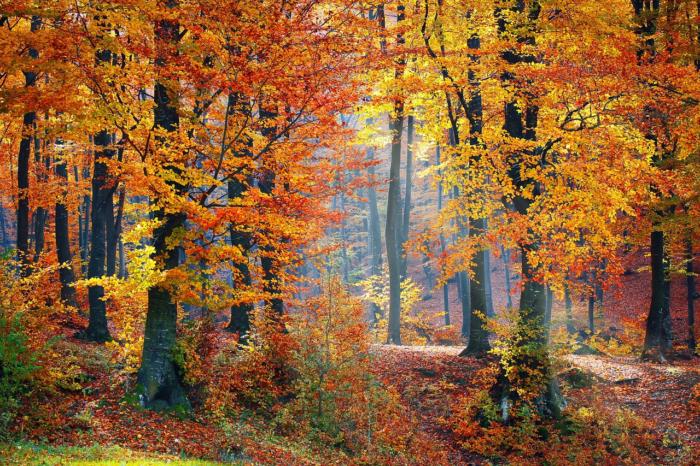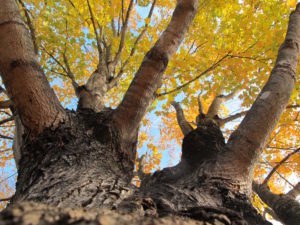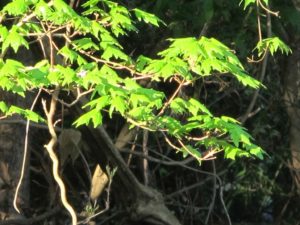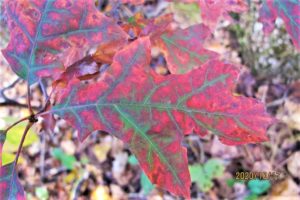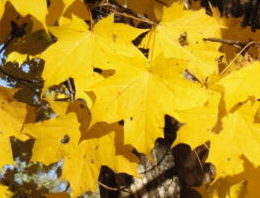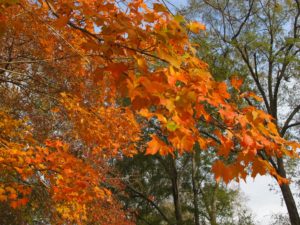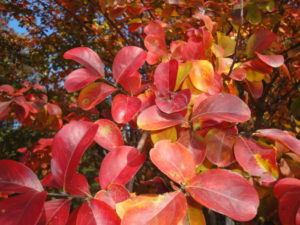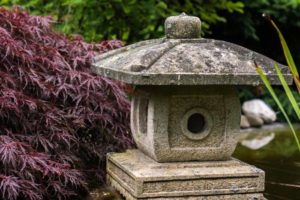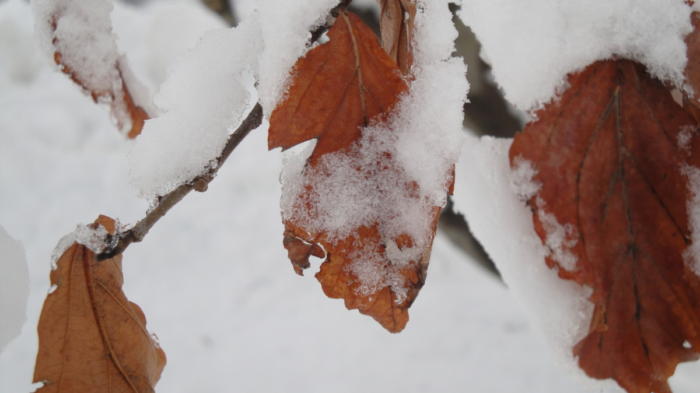Updated 1/23/2025
One of the most phenomenal transformations in nature occurs in autumn when leaves take on fall color.
There’s no mistaking it: vibrant fall color in trees and shrubs signals a new season about to begin.
Deciduous tree canopies change from shades of green to the reds, oranges, yellows, browns, and purples associated with this time of year. A drive along the Blue Ridge Parkway, or even a glimpse out the window to the Japanese maple in the courtyard, elicits feelings of delight and wonder.
Equal to the spectacle unfolding in front of us, as we watch colors brighten from day to day, is the curiosity for an explanation. Why does fall color happen?
Plant Pigments and Fall Color
It all starts with plant pigments, which give leaves their color.
Sandwiched between a leaf’s upper epidermis and the lower epidermis is a layer of cells called the mesophyll. The mesophyll is composed of the upright cells of the palisade layer, near the surface of a leaf, and the more loosely arranged spongy mesophyll. Both kinds of cells within the mesophyll have chloroplasts, which contain chlorophylls “a” and “b”.
Also present within the leaf is a network of vascular tubes—phloem and xylem—which carry water and nutrients between the leaves and the roots.
These chlorophylls absorb wavelengths from different parts of the spectrum. Chlorophyll “a” absorbs violet-blue and orange-red wavelengths, and chlorophyll “b” absorbs blue light. All plants have “a”, but not all plants have “b”. In lower light levels, “b” more efficiently absorbs energy from available light and transfers that energy to “a”.
In autumn, chlorophyll breaks down into transparent compounds. This is when the carotenoids become the dominant colors. Those pigments were there through the summer, but the green chlorophyll masked them. We don’t see the oranges and the yellows until the greens begin to degrade.
Chlorophyll
The green pigment is the familiar chlorophyll. We see it every day as plants grow and produce foliage. Chlorophyll, contained within a cell’s chloroplast, is responsible for manufacturing sugars during photosynthesis. Carbohydrates, made from oxygen and hydrogen in water, and carbon from carbon dioxide, contribute to growth and development of the plant. Green chlorophyll is continually depleted and replenished throughout the season.
Chlorophyll pigments absorb primarily the red and blue wavelengths of the visible spectrum. Most of the green wavelengths, however, are not absorbed and are reflected instead. That why leaves appear green to us.
Changes occur in late summer as days shorten and temperatures drop. Changes in the cells at the base of the leaf’s petiole, where it attaches to the stem, begin to cut off the vascular system. Water and nutrients no longer move freely between the leaves and the stems. Production of new chlorophyll stops, revealing the yellow and orange pigments. Sometimes the leaf veins are the last parts to change color and remain green as the rest of the leaf turns color (photo, above).
Carotenes and Xanthophylls
Carotenoids are composed of xanthophylls and carotenes. These are the yellow, orange, and brown shades seen in plants and animals—daffodils, corn, buttercups, bananas…and canaries, egg yolks, shrimp, fish, and flamingos. These pigments absorb wavelengths from the blue and some of the green parts of the light spectrum, which chlorophyll can’t absorb efficiently.
Xanthophylls and carotenes protect foliage from oxidative stress (cell damage) during photosynthesis. When the tree is exposed to strong sun, carotenoids absorb excess energy from excited chlorophyll molecules and release it as heat. In autumn, carotenes protect leaves as the nutrients are withdrawn from the leaves to the stems. The tree will re-use these nutrients when new foliage emerges in spring.
Beta-carotene, lycopene, lutein, and zeaxanthin are more carotenoids, present in leafy greens, fruits, and vegetables. These pigments are good for plants and for us, too. We see them in squash, tomatoes, sweet potatoes, colorful ripe peppers, carrots, apricots, apples, oranges, and grapefruit. And in the greens, including spinach, kale, collards, and turnip greens. Foods high in these colorful compounds support immunity and help prevent cardiovascular disease and macular degeneration.
Between 15 and 30% of tree species have yellow or orange fall color. Trees that turn these colors include hickory, ash, redbud, yellow poplar, birch, aspen, black cherry, sycamore, maple, fringe tree, cottonwood, sassafras, parrotia, pomegranate, alder, ginkgo, witch hazel, and katsura.
Red twig dogwood ‘Arctic Fire’ and yellow-twig dogwood ‘Flaviramea’ stems turn color in cold weather and good sun. Prune the stems in late winter, almost to the ground, to encourage a multitude of young twigs that will take on color later that fall.
Brown as a Fall Color
Brown is often the color of cell walls and can appear in the absence of other pigments. Sometimes, leaves turn brown as a result of an early freeze. A Japanese maple that normally turns red in autumn, for example, can turn brown when the temperature suddenly plummets.
Also, a tree that has been cut down in late summer or fall will turn brown instead of displaying its usual fall color. More on that on Page 2, under “Marcescence“.
Anthocyanins
What about the red colors? Unlike the yellows and oranges, the red pigments, called anthocyanins, are produced in the sap when sugars break down in bright light.
This happens after some of the chlorophyll has degraded in autumn and as phosphate levels decrease. Phosphates break down sugars manufactured by chlorophyll in the summer in order to carry out cell activities. However, in autumn, phosphates and other nutrients move from the leaves to the stems.
You might notice that in some years, the red colors are more vibrant than in other years. Rich red colors are visible when anthocyanins are produced in greater quantities. Bright sunny days, adequate soil moisture, and cool but not freezing temperatures foster the blazing displays we look forward to each year.
Nutritionists encourage us to “eat all the colors” of vegetables, greens, and fruits. Anthocyanins, among the most powerful antioxidants, are found in many fruits and vegetables, including apples, cranberries, blueberries, strawberries, blackberries, cherries, grapes, plums, red cabbage, and red lettuce.
Carotenoids can combine with anthocyanins to form deep orange, scarlet red, and bronze fall colors.
In temperate regions, about 10% of the trees turn red or burgundy. But the percentage can be as high as 70% in areas such as New England. Some plants with predominantly anthocyanin pigments include maple, oak, sweet gum, tupelo, sourwood, dogwood, cherry, and persimmon. Purple-leaved cultivars of smokebush and redbud turn deep red in autumn.
Variety Selection in Your Landscape
When choosing shrubs and trees for your landscape, be sure to ask the nursery about fall color. There could be several cultivars within a species, each with a different color in autumn.
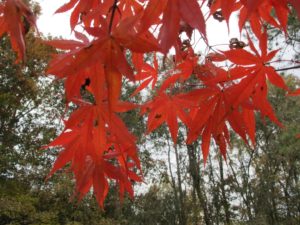
Japanese maple.
Japanese maple (Acer palmatum), for example, comes in many varieties. Red-leaved cultivars of this tree seem to be the preferred choices among customers. Foliage that remains mostly red all summer will gradually deepen to a rich reddish burgundy. And then it suddenly looks as though the plant is on fire, turning bright red. On the other hand, green-leaved cultivars can be multi-colored in the fall, or rich orange, or sunny yellow. It just depends on the cultivar.
If you’re looking for a specimen tree, and fall color is a factor, visit garden centers and public gardens in autumn when the trees show fall color. Research the full botanical names (Genus, specific epithet, and ‘Cultivar’) of the varieties you like.
This is not a guarantee, however, that young potted trees will have the same fall color as established trees. Plants in nursery pots can behave differently than plants in the garden, so take that into consideration.
Fall Color Depends on Weather
- Parrotia persica…
- …beautiful in the snow.
Seasonal weather conditions also affect a tree’s fall color. In the Maryland garden, a Parrotia persica grew in an island bed. The leaves of this witch hazel relative often turned a bright yellow color. In other years it was amber-gold, and, more rarely, salmon-red.
Prolonged mild fall weather can delay abscission. That Parrotia (photos, above) occasionally held its leaves until December. Many oak species keep their orange, russet, rich red, or brown leaves through early winter before shedding them.
Red fall color is particularly dependent upon weather conditions. In 2018, trees that normally turned brilliant red were rather dull here in Charlotte. The heavy rains, high winds, and overcast weather did not promote the production of anthocyanins.
Hormones and Abscission
Abscisic acid (ABA), produced in terminal buds, slows growth and signals the plant to produce bud scales that protect the buds over winter. ABA is also produced in the root system and is translocated to the leaves during drought in the growing season, signaling the leaves’ stomates to close. This reduces transpiration, conserving water content in the plant.
Hormones produced in leaves and in the tips of twigs influence development of the abscission layer. This layer is a few cells thick, characterized by short cells with thin walls, and sits between the base of the leaf stem (petiole) and the twig.
During the growing season, higher levels of auxin regulate the influence of ethylene—both are hormones—resulting in the leaves’ ability to remain attached. Auxin levels fall in autumn, however, exposing cells in the abscission layer to the effects of ethylene, which promotes leaf detachment.
Cells between the petiole and the twig are differentiated, disintegrating on the leaf end and depositing lignin and suberin on the twig side. As this layer of cells weakens, leaves to fall off by their own weight or with wind and rain. Enzymes, such as pectinases, help the process by breaking down cell walls.
Remaining on the twig is a leaf scar, with remnants of vascular strands. Over several days, lignin (tough woody tissue) and suberin (corky bark tissue) seal the fresh leaf scar, protecting it from infection and desiccation.
Headings
Page 1: Plant Pigments and Fall Color, Chlorophyll, Carotenes and Xanthophylls (Brown as a Fall Color), Anthocyanins, Variety Selection in Your Landscape, Fall Color Depends on Weather, Hormones and Abscission
Page 2: Marcescence (Nutrient Release, Browsing Animals, Weather Abatement), Why Do Leaves Fall Off?, Protective Red Fall Color, But Only Part of the Tree is Turning Color, Fall Color and Species Distribution, Speaking of Cold, Fall color is nature’s last hurrah of the season.
